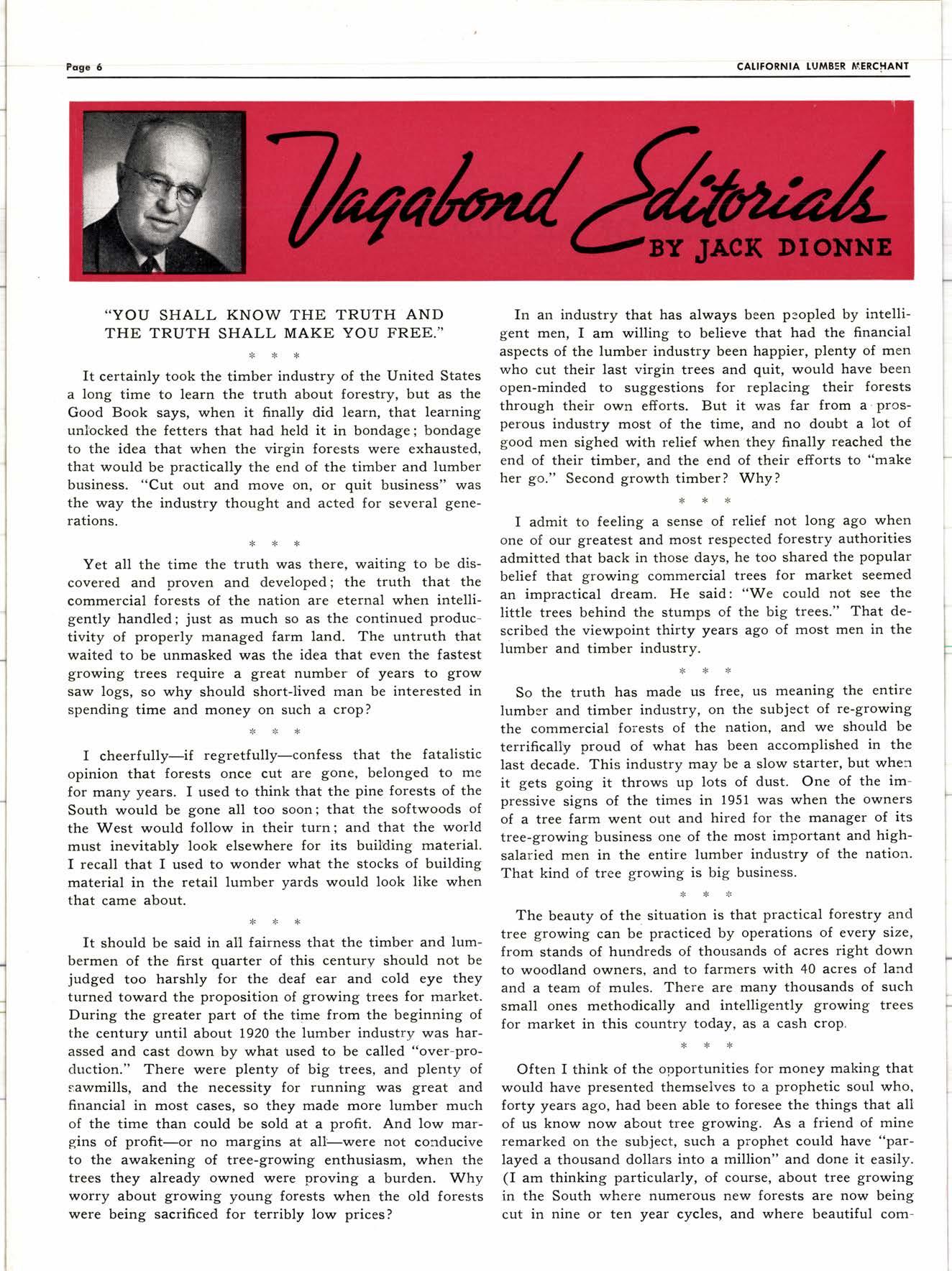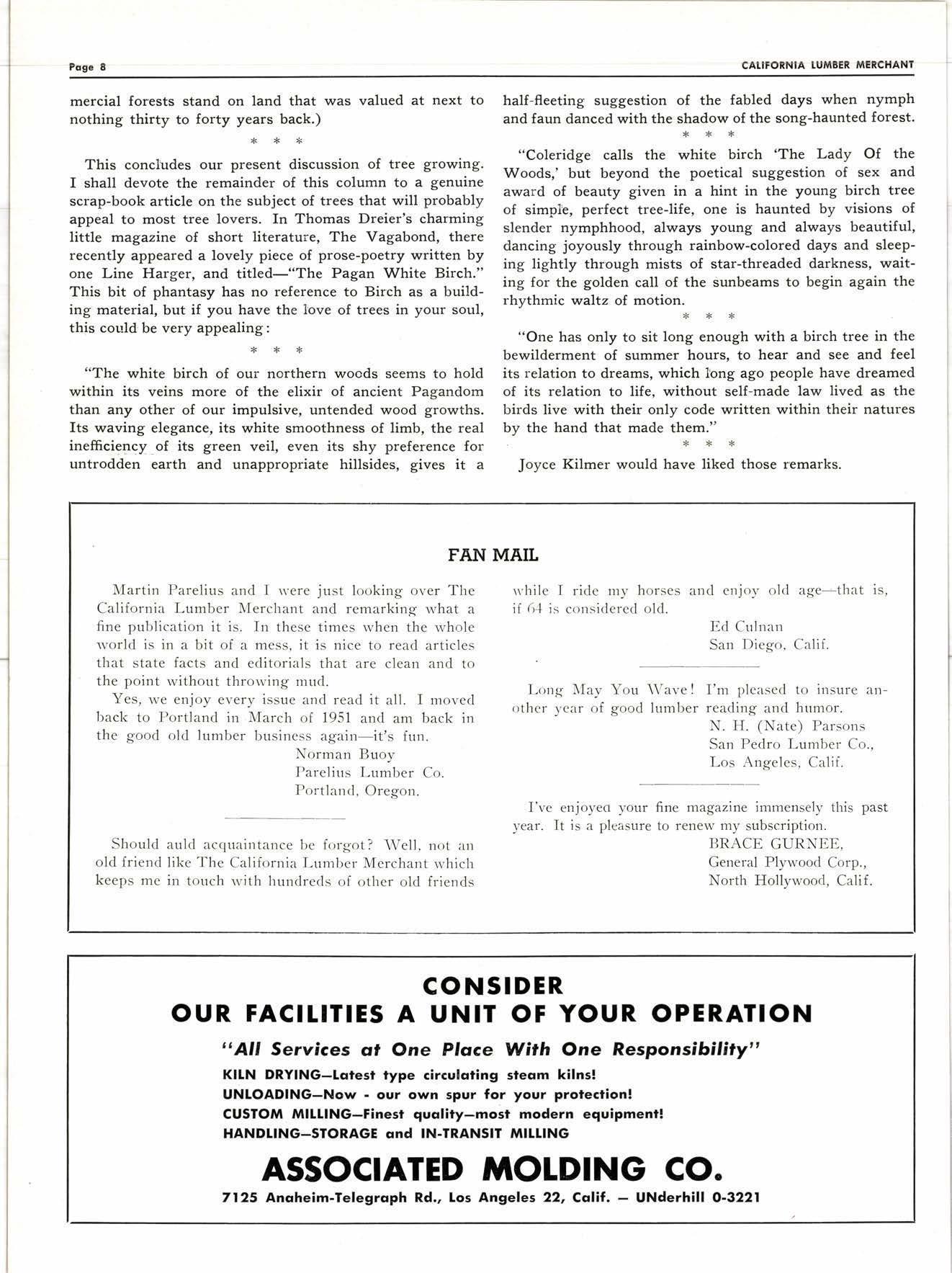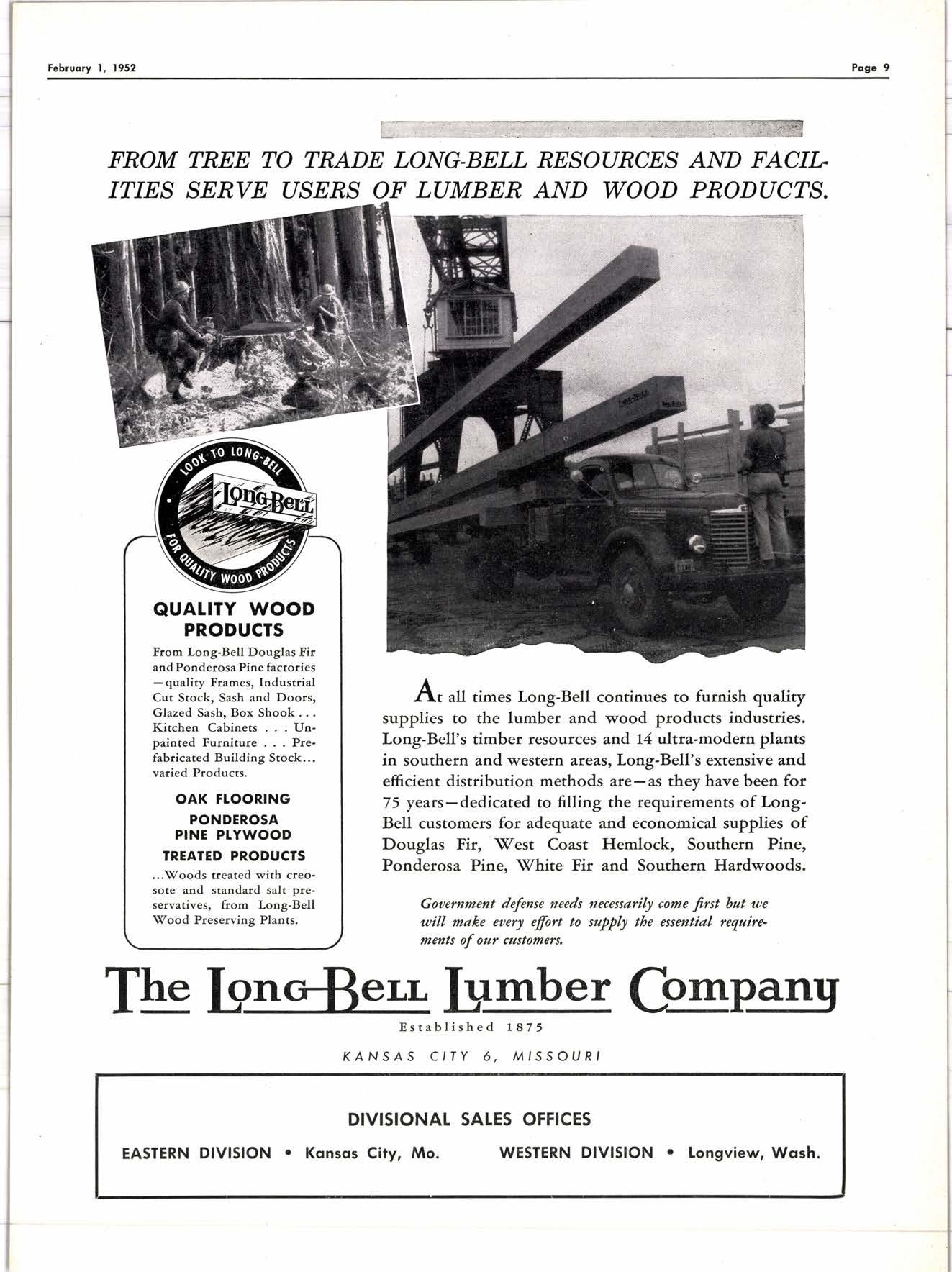
8 minute read
Eells-\(/alker
Plywood a Door Co.
New Los Angeles Concern
the Navl'. He servecl n'ith the SeaBees on Attu in the Aleutian Islands. He has been in Southern California over fir.e years and lives in Pasadena.
When intervien'ed, N{r. Eells was very emphatic in sayilg, "We have no fault to find with these times or this market. While it's true that the frantic market createcl by the past war boom and scarcity has subsided someu'hat, plyt'ood is stil1 the fincst and most economical procluct for its many, ma11y uses and der.nand resulting from \\.ar uses u'ill certairrlv sustain our business and any other' clcdicated to fair practices and sirrcere service."
The [,el1s-\\'a1ker Plyrvoocl & Door Co., as the nan-re implies, r'vill confine itself to sales of hardrvood and softrvood pl1'u'oocl and harcln,oocl flush type doors. The Company is very fcirtunate in having the exclusive representation of tn'o very hne eastcrn manufacturers. The Company rvill carry in its l'arehouse and n'ill offer from the mill cloors by t1.re llardu'oocl l'roducts Corporation of Neenah, Wis. This firm has been manufacturing solid core hardn'oocl doors for over forty years and in addition to its regular line produces the l{iverbank Sound Insulating I)oors, of national reputatiorl, iind a r.vood veneered fireproof door. Numbe:ed among the prominent jobs rvhich have used Harcln'ood Products doors is the Hotel Waldorf ir.r Nerv York Citv. Hardl.ood Products is a particulrrrlv meticulous manufacturer, follorving the most detailed achitects' specifications. Ile11s-\\'a1ker rrill maintain a stocl< of these ckrors in its local n'arehouse at all times.
The Compzrny rvill har-e the exclusive representation for hardn'ood plyn,ood ancl veneer of the Underrvood Veneer Co. of Wansau, \\'is. This firn"r is a dir-ision of the Connor Lumber Co. and has been producing fine plyl.ood and veneer since 1893. Custom n.racle 1>anels u'il1 augment the stock panels available at the u'arehouse.
Lr addition, Eel1s-\\ralker P11 n'ood & Door Co. u'il1 carry a complete stock of Douglas fir plvrvoocl in sizes ar.rtl cluantities to fit dealers' daily requircments. A line of hollorv core doors n'il1 be aclded later.
The E,ells-\\ralker P11.rvood & Door Co. is open {or business permanently and is at present serving dealers in Sonthern California. The phone number is ADams 3-5162.
It certainly took the ar*., ,"*stry of the United States a long time to learn the truth about forestry, but as the Good Book says, when it finally did learn, that learning unlocked the fetters that had held it in bondage; bondage to the idea that when the virgin forests were exhausted, that would be practically the end of the timber and lumber business. "Cut out and move on, or quit business" was the way the industry thought and acted for several generations.
Yet all the time tn. tr,ltn -*"1 .n.r., waiting to be discovered and proven and developed; the truth that the commercial forests of the nation are eternal when intelligently handled; just as much so as the continued productivity of properly managed farm land. The untruth that waited to be unmasked was the idea that even the fastest growing trees require a great number of years to grow saw logs, so why should short-lived man be interested in spending time and money on such a crop?
I cheerfully-if regre,*rr-**ess that the fatalistic opinion that forests once cut are gone, belonged to me for many years. I used to think that the pine forests of the South would be gone all too soon; that the softwoods of the West would follow in their turn; and that the world must inevitably look elsewhere for its building material. I recall that I used to wonder what the stocks of building material in the retail lumber vards would look like when that came about.
rt should be said ir, "fl Li.ll.rl ,r,., the timber and lumbermen of the first quarter of this century should not be judged too harshly for the deaf ear and cold eye they turned toward the proposition of growing trees for market. During the greater part of the time from the beginning of the century until about 1920 the lumber industry was harassed and cast down by what used to be called "over-production." There were plenty of big trees, and plenty of sawmills, and the necessity for running was great and financial in most cases, so they made more lumber much of the time than could be sold at a profit. And low mar. gins of profit-or no margins af all-s'7sse not conducive to the awakening of tree-growing enthusiasm, when the trees they already owned were proving a burden. Why worry about growing young forests when the old forests were being sacrificed for terribly low prices?
fn an industry that has always been peopled by intelligent men, I am willing to believe that had the financial aspects of the lumber industry been happier, plenty of men who cut their last virgin trees and quit, would have been open-minded to suggestions for replacing their forests through their own efforts. But it was far from a prosperous industry most of the time, and no doubt a lot of good men sighed with relief when they finally reached the end of their timber, and the end of their efforts to "make her go." Second growth timber? Why?
I admit to feeling " ..1-rr.* of relief not long ago when one of our greatest and most respected forestry authorities admitted that back in those days, he too shared the popular belief that growing commercial trees for market seemed an impractical dream. He said: "We could not see the little trees behind the stumps of the big trees." That described the viewpoint thirty years ago of most men in the lumber and timber industrv.
***
So the truth has made us free, us meaning the entire lumber and timber industry, on the subject of re-growing the commercial forests of the nation, and we should be terrifically proud of what has been accomplished in the last decade. This industry may be a slow starter, but when it gets going it throws up lots of dust. One of the impressive signs of the times in 1951 was when the owners of a tree farm went out and hired for the manager of its tree-growing business one of the most important and highsalaried men in the entire lumber industry of the nation. That kind of tree growing is big business.
The beauty of the- ,ia,r"liori i"',tr", practical forestry ancl tree growing can be practiced by operations of every size, from stands of hundreds of thousands of acres right down to woodland owners, and to farmers with 40 acres of land and a team of mules. There are many thousands of such small ones methodically and intelligently growing trees for market in this country today, as a cash crop.
Often I think of the "O*r,""rdes for money making that would have presented themselves to a prophetic soul who, forty years ago, had been able to foresee the things that all of us know now about tree growing. As a friend of mine remarked on the subject, such a prophet could have "parlayed a thousand dollars into a million" and done it easily.
(I am thinking particularly, of course, about tree growing in the South where numerous new forests are now being cut in nine or ten year cycles, and where beautiful com-
4 utdJ-/rt arrn naftip *o t/n U"rf-A lrtelJ-l*nun, nane da Ar4til,lten the best in Fir Redwood r Pine Red Cedar

P ilin s
Rai I or Cargo mercial forests stand on land that was valued at next to nothing thirty to forty years back.)
This conctudes our nr;.; ul"".rr"ror, of tree growing. I shall devote the remainder of this column to a genuine scrap-book article on the subject of trees that will probably appeal to most tree lovers. In Thomas Dreier's charming little magazine of short literature, The Vagabond, there recently appeared a lovely piece of prose-poetry written by one Line Harger, and titled-"The Pagan White Birch." This bit of phantasy has no reference to Birch as a building material, but if you have the love of trees in your soul, this could be very appealing:
"The white birch of "; ;r,Lrn woods seems to hold within its veins more of the elixir of ancient Pagandom than any other of our impulsive, untended wood growths. Its waving elegance, its white smoothness of limb, the real inefficiency-of its green veil, even its shy preference for untrodden earth and unappropriate hillsides, gives it a half-fleeting suggestion of the fabled days when nymph and faun danced with the shadow of the song-haunted forest.
"Coleridge calls the white birch 'The Lady Of the Woods,' but beyond the poetical suggestion of sex and award of beauty given in a hint in the young birch tree of simple, perfect tree-life, one is haunted by visions of slender nymphhood, always young and always beautiful, dancing joyously through rainbow-colored days and sleeping lightly through mists of star-threaded darkness, waiting for the golden call of the Sunbeams to begin again the rhythmic waltz of, motion.
"One has only to sit long enough with a birch tree in the bewilderment of summer hours, to hear and see and feel its relation to dreams, which lbng ago people have dreamed of its relation to life, without self-made law lived as the birds live with their only code written within their natures by the hand that made them."
Joyce Kilmer would n"; ;J those remarks.
Fan Mail
Martin Parelius and I rvere just looking over The California Lumber Mercl-rant and remarking what a fine publication it is. In these times when the whole world is in a bit of a mess, it is nice to read articles that state facts and editorials that are clean and to the point without throwing mud.
Yes, we enjoy every issue and read it all. I movecl back to Portland in March of 1951 and am back in the good old lumber business again-it's fun.

Norman Buoy Parelius Lumber Co. Portland, Oregon.
Should auld acquaintance be forgot? Well, not an old friend like The California Lumber Merchant which keeps me in touch with hundreds of other old friends rvhile I if 64 is ride my horses cor-rsidered old.
Long N{ay You other year of good and enjoy old age-that
Ed Culnan San Diego, Calif.
1S,
Wave ! lumber
I'm pleased to insure anreading and humor.
N. H. (Nate) Parsons San Pedro Lumber Co., Los Angeles, Calif.
I've enjoyeo your fine magazine immensely this past year. It is a pleasure to renew my subscription.
BRACE GURNEE, General Plywood Corp., North Hollywood, Calif.
FROM ITIES TREE TO TRADE LONG.BELL RESOURCES AND FACIL SERVE USENS OF LUMBER AND WOOD PRODUCTS.
QUATITY WOOD PR,ODUCTS
From Long-Bell Douglas Fir and Ponderosa Pine factories -quality Frames, Industrial Cut Stock, Sash and Doors, Glazed Sash, Box Shook... Kitchen Cabinets Unpainted Furniture Prefabricated Building Stock... varied Products.
OAK FTOORING
PONDEROSA
PINE PTYWOOD
TREATED PRODUCTS l At all times Long-Bell continues to furnish quaLity supplies to the lumber and wood products industries. Long-Bell's timber resources and 14 ultra-modern plants in southern and westefn areas, Long-Bell's extensive and efficient distribution methods are-as they have been for 75 years-dedicated to filling the requirements of LongBell customers for adequate and economical supplies of Douglas Fir, 'W'est Coast Hemlock, Southern Pine, Ponderosa Pine,'White Fir and Southern Hardwoods.
...Voods treated with creosote and standard salt preservatives, from Long-Bell Vood Preserving Plants.
Gooernrnent defense needs necessarily come first bat ute utill nake eaery efort to supply the essential rcqaire. tnents of our castotncrs,











